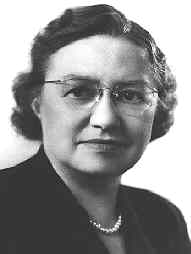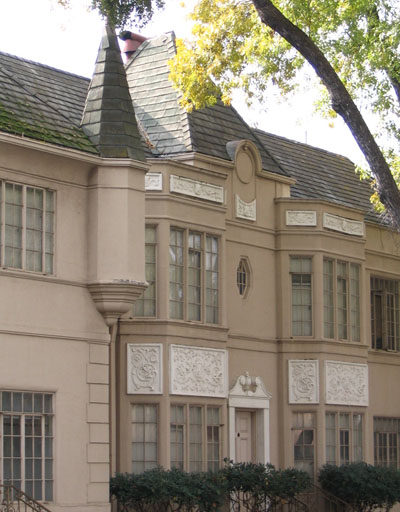Edith Mortensen Northman: Tower District Architect
By John Edward Powell
 No neighborhood in Fresno is more
associated with architectural style than the Tower District, described as the
"Soho of the San Joaquin." Its neon personality defined by the
Tower Theatre's lofty illuminated spire and
flashing marquee at its hub, the district has become synonymous with the early
modernistic history of this community.
No neighborhood in Fresno is more
associated with architectural style than the Tower District, described as the
"Soho of the San Joaquin." Its neon personality defined by the
Tower Theatre's lofty illuminated spire and
flashing marquee at its hub, the district has become synonymous with the early
modernistic history of this community.
Lively, theatrical, arty and rakishly stylish, the district owes much of its allure to its architecture. Besides the 1939 theater designed by Los Angeles architect S. Charles Lee, several other commercial buildings were built in late Art Deco design traditions. Huebner Sports (now Tower Florist) was designed in 1938 by Fresno architect Allen C. Collins. His little corner sports shop was an early progenitor of streamlined design on Olive Avenue, followed by Lauck's Bakery in early 1939. The old Carnation Restaurant, constructed in 1946, was the last of the sleek moderne buildings to go up on the street.
The theater, its tower fashioned after an electrical display at the futuristic 1939 New York World's Fair, is the cultural beacon at the crossroads of this entertainment district. But residential architecture in the neighborhood did not evolve along the same modernistic lines.
 If the Tower
Theatre is the queen of the district, the fanciful Normandie Mar Apartment
Hotel (shown on left) is the neighborhood's crown jewel, and the only known
work in the San Joaquin Valley by Los Angeles architect Edith Mortensen
Northman. Built the same year as the Tower Theatre, the Normandie Mar is
designed in the West Los Angeles tradition of swank French Eclectic-inspired
apartment buildings, with wonderfully embellished chateauesque characteristics.
It is like no other building in Fresno, and was designed by a woman described
in 1937 by the Los Angeles Times as "Los Angeles' only woman architect."
If the Tower
Theatre is the queen of the district, the fanciful Normandie Mar Apartment
Hotel (shown on left) is the neighborhood's crown jewel, and the only known
work in the San Joaquin Valley by Los Angeles architect Edith Mortensen
Northman. Built the same year as the Tower Theatre, the Normandie Mar is
designed in the West Los Angeles tradition of swank French Eclectic-inspired
apartment buildings, with wonderfully embellished chateauesque characteristics.
It is like no other building in Fresno, and was designed by a woman described
in 1937 by the Los Angeles Times as "Los Angeles' only woman architect."
Edith Mortensen Northman was born on October 8, 1893, in Copenhagen, Denmark. Her Danish father and Swedish mother moved between their native countries until Edith was nine, when the family moved to Norway. There she attended and graduated from high school in Haugersund. Returning to Copenhagen, she completed two years study in the Studio School of Arts, Atelier Frede Aamodt. She immigrated with her family to the United States in 1914.
Settling in Brigham City, Utah, which she called "the Wild West," Northman worked as a librarian from 1917 to 1918. She "read something about architects," and decided that was what she wanted to do. Moving to Salt Lake City in 1918, she found architectural work in the office of Eugene R. Wheelon as a junior draftsman.
On the advice of her physician, she moved to Southern California in 1920. In Los Angeles, she worked with architect Henry J. Knauer and later with Clarence J. Smale as chief draftsman. As she later recalled, "In those days, the early '20s, women in architects' offices were somewhat curiosities," and "[I] got into one office on the strength of being able to typewrite with two fingers." But, as she reflected, "my drafting was too good, thank goodness."
Edith studied architecture at the University of Southern California from 1927 to 1930, and passed the state board examination in 1931. During the Depression, assisted only by a draftsman, she compiled an exceptional catalog of clients, designing hundreds of projects: residences, apartments, churches, commercial buildings, factories. In the mid-1930s she landed a large commission with Union Oil Co. and designed more than 50 service stations from San Diego to Vancouver. She was proud of her Danish Lutheran Church in Los Angeles, built in 1937 in the Danish country-church style, which she described in total understatement as "not too bad."
According to her nephew, Washington columnist Jack Anderson, Northman was an "enormously private" person who lived a frugal life with her dachshund "Hans." Anderson said she succeeded because she was "competent" and "brilliant" in a man's career.
Northman had a number of clients in the film industry, including Danish actor Jean Hersholt, for whom she did work on his Rodeo Drive home in Beverly Hills. Her most intriguing association with Hollywood, however, came from Samuel Goldwyn Studios. Goldwyn was producing Dorothy Parker's "Woman Chases Man" (1937), starring Mariam Hopkins in the role of woman architect Virginia Travis. Finding out that a real woman architect existed, they sent a limousine for Northman to meet the star and see them make the picture. Northman remarked that she watched the film character "do quite unbelievable things in the pursuit of the illusive client."
Northman's design for the Normandie Mar was prepared for a local woman, E. E. Elzea, who had seen one of Northman's Los Angeles projects. Elzea sought Northman out in 1939 to prepare plans for her Fresno complex on the southeast corner of Wishon and Home Avenues. The Normandie Mar imparts a sophistication to the district in dramatic counterpoint to the flashy neon flamboyance of her landmark theater neighbor.
During World War II, Northman joined the U.S. Army Corps of Engineers, working in fortifications and military engineering. She designed "everything under the sun from pit latrines to hospital buildings." After the war she returned to private practice, specializing in large apartment buildings and hotels in Los Angeles and Palm Springs.
Edith Northman was stricken with Parkinson's disease in the early 1950s. A niece, Judith Cairnie, observed that it was "a dismal end for a proud and talented woman." Unable to hold a pencil, Northman became "helpless, silent and very stoic," and was forced to retire from the practice of architecture in which she "had lots of fun," didn't "expect to get rich doing it, but wouldn't have changed for anything else." She died in Salt Lake City in 1956, her remarkable career all but forgotten until the work of women in architecture became the focus of several studies in the last decade.
Northman once mused that while a little girl she "loved watching buildings go up, but didn't tell anyone. It wasn't 'ladylike.'" Fresno's Tower District is much richer architecturally because Edith Mortensen Northman allowed a childhood fantasy to become an adult woman's career achievement.
John Powell has taught American architectural history at Fresno City College and California State University, Fresno. He studied the career of Edith Mortensen Northman with a grant from the National Endowment for the Arts in 1987-1988.
This article originally appeared in The Fresno
Bee, 11 May 1990, page F4.
© 1990 The Fresno Bee. All rights
reserved. Used by permission.
Photo of Edith Northman courtesy of the Anderson family.
For additional information on Edith Mortensen Northman and other early twentieth-century women architects in California, see:
Favro, Diane, "A Region for Women: Architects in Early California," Architecture California, February 1991.
Gebhard, David, Lutah Maria Riggs: A Woman in Architecture, 1921-1980, Santa Barbara: Capra Press, 1992.